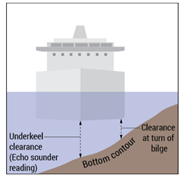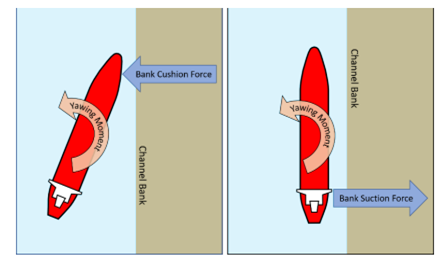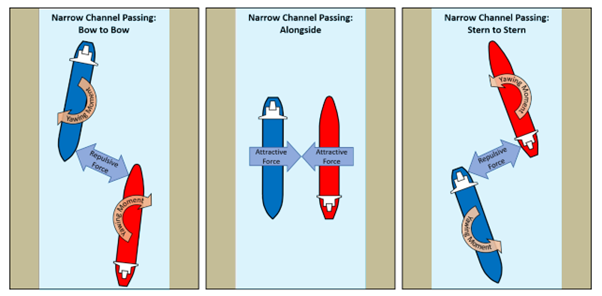Transiting narrow waterways is never routine. Subtle hydrodynamic forces like bank effect, squat, and ship interaction, can quickly turn a controlled passage into a dangerous situation.

Hydrodynamic forces when transiting narrow waterways – don’t lose control
Written by
Published 18 September 2025
“I’m gonna probably hit ya…sound your general alarm!”
These were the harrowing words of the pilot guiding an LPG carrier to the captain of the tug and tow it was approaching in a restricted channel. Fortunately, the ensuing collision with a barge resulted in no reported injuries. It did, however, result in an oil spill and temporary closure of the channel.
The official investigation found, among other things, that the combined effect of the speed of the LPG carrier passing another large vessel in the channel resulted in an uncontrollable sheer , which ultimately led to the collision. Such sheer is an example of a hydrodynamic force which typically occurs when transiting narrow waterways.
An underestimated risk
The typical risks facing a ship transiting a narrow waterway, such as a river, canal, port fairway or dredged channel, are reasonably understood. However, the risk of hydrodynamic interactions between the transiting ship and other ships or the perimeters of the waterway, can be underappreciated. These subtle, yet powerful, forces can compromise a vessel’s manoeuvrability. A sudden sheering of the vessel’s direction and an inability to control or counter-act can come as a complete surprise to the bridge team.
Hydrodynamic effects are not new. At the turn of the 20th Century when the Kiel Canal was in its infancy, accidents were a frequent occurrence with as much as 1 in every 20 transiting ships ending up a wreck. The lack of familiarity with interactive forces led to compulsory pilotage. Fast forward a hundred years and following a succession of accidents the UK Maritime and Coastguard Agency (MCA) issued a 2002 guidance on the dangers of interaction. Still today accident investigation bodies point to interaction as a significant contributory factor in a number of serious casualties.
Skilled pilots help to reduce the likelihood of occurrence, yet two very similar incidents in the same location recently occurred within 16 months of each other. Waterway infrastructure does not necessarily change in step with increasing vessel size. Larger vessels have lower margins for error and can do more damage. Beyond the risk of harm to people and the environment, the economic consequences of casualties are growing in severity. Whether from a grounding, collision or contact with other vessels or objects, it can be particularly costly if the use of the waterway is affected or if vessel damage extends to the rudder and/or propellor. It is also well to remember that the legal consequences are most often felt by the master and shipowners, since in most jurisdictions the pilot is treated as a servant of, or advisor to, the ship. Even where pilots face liability, it is often very limited.
Hydrodynamic forces explained
Ships transiting a narrow channel are usually affected by squat and trim effects. They can also be affected by bank effect forces and interactions between passing ships. These interactions can be experienced at distances greater than what might be assumed.
When a vessel is in motion in shallow water, it will experience both sinkage (squat) and a tendency for its forward and aft drafts (trim) to change. This affects how the vessel behaves in response to helm and engine orders. If squat has not been sufficiently allowed for it can result in touching bottom.

Source: National Transportation Safety Board (NTSB)
As a ship approaches the bank of a narrow channel, an area of high pressure builds near the bow, which tends to push, or sheer, the bow away from the bank, an effect known as “bank cushion or rejection.” Yawing of the bow away from the bank results in the stern drawing towards it. An area of low pressure is then created between the bank and the ship as the same volume of water pushes through less space. This creates a “bank suction” effect that acts on the entire ship, with the strongest influence around midships where the hull is fullest.

Source: NTSB
Two ships passing in a narrow channel introduce additional hydrodynamic effects. In the case of two vessels meeting head-on, the bow wave ahead of each vessel creates repulsive forces between the two vessels (toward opposite banks) as they approach. When the ships are side by side, the interactive forces are reversed and become attractive, tending to bring the vessels closer toward one another. As the vessels pass stern to stern, the forces become repulsive again, which tends to turn the vessels back toward the center of the channel. In a straight channel with symmetrical banks, the forces of bank cushion and bank suction are also acting on the two passing vessels.

Source: NTSB
Transit planning considerations
A significant planning consideration is the vessel’s speed through the water. Higher speeds increase the hydrodynamic forces and risks. Since interaction force varies with speed squared, (i.e. 2 x speed = 4 x forces), it is very sensitive to even small increases in speed. However, if the vessel’s speed is too low that can also be a detriment to maneuvering, especially in strong tides, currents or windy conditions. The latter may be especially relevant for vessels with a large sail area. The dimensions of a vessel may pose a particular challenge when encountering bends and reduced visibility may hamper position monitoring. All things considered, it may be prudent to postpone a transit or evaluate whether it can proceed with suitable tug support. Restrictions will often apply for night transits.
Waterway rules and guides, as well as publications such as the Admiralty Sailing Directions, will provide information on the use of the waterway including its underwater form and features. Depths will often reduce from the centerline and there may be significant sloping at the sides. Features may include buoyage and particular hazards including areas with strong current/tide or which are prone to shoaling. Local agents should be able to advise on the status of dredging operations. Consideration should be given to cross-track allowances/errors (from the planned track in the waterway) and the benefit of parallel indexing and marking of no-go areas in the passage plan. A mental model of safety margins in ship breadths can be useful.
The Master/Pilot Exchange provides a final opportunity to plan for hydrodynamic effects. Conditions may deteriorate during an approach, and they may call for an abort point. Planned movements of other vessels can also be discussed and if passing is to be expected, where and how that should best take place. Some accident investigations have concerningly found that masters and pilots often have too little time for a proper exchange, leading to them not sharing the same mental model.
Monitoring the transit
Monitoring the transit in a narrow waterway requires task focus by the whole bridge team, including the pilot. The master (or his delegate on a long transit) knows best how the ship handles, so should not be distracted from observing that during the transit. Indications of hydrodynamic effects may reveal themselves sufficiently early in the transit for corrective actions to be taken, such as speed reduction. How much helm is being applied and how the ship is responding to helm in relation to the speed and echo sounder depths can all be useful indicators. The helmsperson should be briefed to report any difficulties.
Monitoring the position of the vessel in the narrow channel is crucial and space may be more limited than planned due to berthed vessels. A bridge team member should have this role and report early to the master so that adjustments can be made. There have been reports of pilots requiring radars and ECDIS to be switched off. Alarms are one thing, but this is otherwise unacceptable. Pilots may also have their own portable pilotage unit and an independent location feed provides a level of redundancy.
Monitoring the pilot is essential in narrow waterways, especially in relation to speed. High speed not only increases hydrodynamic effects –it also reduces reaction time and the power in reserve from an engine kick to increase the flow of water across rudder. Attention is needed when turning for bends in the waterway, as currents and tides can affect the maneuver. Turns made too early or late, depending on the lateral position, may bring bank effect into play. If vessels meet unexpectedly, choose the best passing place and adjust speed if considered best to avoid bends. Passing vessels should take account of the need to avoid bank effect as well as interaction between the vessels.
The master should be acquainted with the actions expected of a pilot to pre-empt the effects of interaction and should not hesitate to raise concerns.
Building on transit experience
Even a successful transit can involve moments of concern. Masters are encouraged to discuss those with pilots before disembarkation in order to learn from the experience and share knowledge within the fleet.
Companies having vessels particularly at risk in frequently transited waterways, can seek to forge closer relations with pilotage, vessel traffic and waterway authorities. Insight to and discussion around experience and challenges will help in aligning risk controls. This could be even more effective in the form of a waterway user forum, along with other frequent users.
Experience may reveal the need for enhanced training of senior officers. Risk management policies and procedures, notably in relation to waterway entry and speed considerations, should also be kept under review based on own experience and that gained from other users.
A fuller understanding of hydrodynamic effects and how they can be counter-acted can be found in accident reports linked to this Insight. Greater appreciation and planning for interaction risks will assist the bridge team to avoid dangerous encounters similar to the one at the beginning of this Insight.



